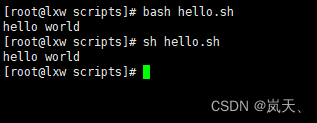查看当系统有什么shell解释器:cat /etc/shells

CentOs默认用的是 bash : echo $SHELL
Shell 脚本入门
1、脚本格式:
脚本要以 #!/bin/bash 开头 用来指定解析器
创建第一个脚本 hello.sh:
# 编写脚本 也可以不写.sh指定后缀
vim hello.sh
#!/bin/bash
echo hello world
echo "hello world bash " >> lxw.txt第一行 #!/bin/bash 用来指定解析器bash
第二行输出一行hello world
第三行 将 hello world bash 追加到 lxw.txt文件中
执行脚本:
bash 脚本名称
sh 脚本名称

文件名执行脚本 ./hello.sh
会发现权限不够,因为当前的用户权限是读写 rw-,并没有可执行权限x
我们就需要更改脚本文件权限

# 方式一hello.sh 脚本的+x 权限
chmod +x hello.sh
# 方式二 二进制更改
chmod 744 hello.sh
发现更改权限之后可以用脚本名称直接去执行脚本了
source hello.sh . hello.sh 执行脚本
这里的 . 脚本名 跟之前的./是不一样的 ./是相对路径 这里的 . 是shell内嵌命令 type source

source 对比 bash sh 的区别
前两种方式(bash、sh)都是在当前
shell
中打开一个子
shell
来执行脚本内容,当脚本内容结束,则子 shell
关闭,回到父
shell
中。
第三种,也就是使用在脚本路径前加“ .”或者
source
的方式,可以使脚本内容在当前 shell 里执行,而无需打开子
shell
!这也是为什么我们每次要修改完
/etc/profile
文件以后,需要 source
一下的原因。
开子 shell 与不开子 shell 的区别就在于,环境变量的继承关系,如在子 shell 中设置的
当前变量,父 shell 是不可见的